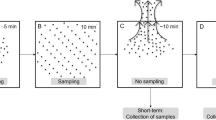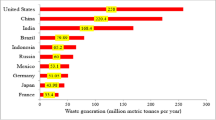Abstract
Currently odor problems caused by animal feeding operation play a role in provoking environmental civil petition. The objectives of this study were to investigate the monthly distribution characteristics of 22 offensive odor compounds in swine houses, which are under regulation in Korea, and to compare their levels according to ventilation type and manure treatment mode. During the 1 year survey between July 2021 and June 2022, air samples were collected. In this study, ammonia was observed at the highest levels (the annual mean, 13.9 × 103 ppb) among other offensive odorous compound regardless of the types of swine house and seasons, followed by fatty acids (139.9 ppb), sulfuric odorous compounds (52.3 ppb), volatile organic compounds (27.5 ppb), and trimethyl amine (24.5 ppb). Furthermore, hydrogen sulfide among sulfur compounds, methyl ethyl ketone among volatile organic compounds, and propionic acid and n-butylic acid among fatty acids were observed to the highest level of several hundreds of ppb. In particular, five aldehydes (acetaldehyde, propionaldehyde, butyraldehyde, n-valeraldehyde, and i-valeraldehyde) among the 22 offensive odor-generating compounds were not detected in any season. The levels of odorous compounds were the highest in winter (Dec.–Feb.) and lowest in summer (June–Aug.). For comparison of overall distribution regarding concentrations of odorous compounds by ventilation type and manure removal mode, relatively lower concentrations were observed in swine houses with forced ventilation or with scrapper type. Our findings indicate that annual monitoring for these odorous compounds would be necessary for establishment of control strategy. Also, installation of active ventilation, as well as the increase of removal frequency of pig manure could contribute to lower concentrations of odorous compounds in swine buildings.







Similar content being viewed by others
Data availability
The datasets generated during and/or analyzed during the current study are not publicly available due to permission of the institution that supported the current study but are available from the corresponding author on reasonable request.
References
Aatamila M, Verkasalo PK, Korhonen MJ, Suominen AL, Hirvonen MR, Viluksela MK (2011) Odour annoyance and physical symptoms among residents living near waste treatment centres. Environ Res 111(1):164–170
Arogo J, Westerman PW, Heber AJ, Robarge WP, Classen JJ (2002) Ammonia emissions from animal feeding operations. In: National Center for Manure and Animal Waste Management White Papers. North Carolina State University, Raleigh, N.C
Bicudo JR, Schmidt DR, Gay SW, Gates RS, Jacobson LD, Hoff SJ (2002) Air quality and emissions from livestock and poultry production waste management systems. In: National Center for Manure and Animal Waste Management White Papers. North Carolina State University, Raleigh, N.C
Chang CW, Chung H, Huang CF, Su HJJ (2001) Exposure assessment to airborne endotoxin, dust, ammonia, hydrogen sulfide and carbon dioxide in open style swine houses. Ann Occup Hyg 45(6):457–465
Chen L, Hoff S, Cai L, Koziel J, Zelle B (2009) Evaluation of wood chip-based biofilters to reduce odor, hydrogen sulfide, and ammonia from swine barn ventilation air. J Air Waste Manag Assoc 59:520–530
Crook B, Robertson JF, Glass SA, Botheroyd EM, Lacey J, Topping MD (1991) Airborne dust, ammonia, microorganisms, and antigens in pig confinement houses and the respiratory health of exposed farm workers. Am Ind Hyg Assoc J 52(7):271–279
Duchaine C, Grimard Y, Cormier Y (2000) Influence of building maintenance, environmental factors, and seasons on airborne contaminants of swine confinement buildings. Am Ind Hyg Assoc 61(1):56–63
Gay SW, Schmidt DR, Clanton CJ, Janni KA, Jacobson LD, Weisberg S (2003) Odor, total reduced sulfur, and ammonia emissions from animal housing facilities and manure storage units in minnesota. Appl Eng Agric 19(3):347–360
Groot Koerkamp PWG, Metz JHM, Uenk GH, Phillips VR, Holden MR, Sneath RW (1998) Concentrations and Emissions of Ammonia in Livestock Buildings in Northern Europe. J Agric Eng Res 70(1):79–95
Guo H, Wang Y, Yuan Y (2011) Annual variations of odor concentrations and emissions from swine gestation, farrowing, and nursery buildings. J Air Waste Manag Assoc 61(12):1361–1368
Gustafsson G (1999) Factors affecting the release and concentration of dust in pig houses. J Agric Eng Res 74(4):379–390
Hamon L, Andres Y, Dumont E (2012) Aerial pollutants in swine buildings: a review of their characterization and methods to reduce them. Environ Sci Technol 46:1287–1231
Hartung J, Hilliger HG (1984) Odour characterization in animal houses by gas chromatographic analysis on the basis of low temperature sorption. Applied Science Publishers, pp 561–578
Hartung J, Phillips VR (1994) Control of gaseous emissions from livestock buildings and manure stores. J Agric Eng Res 57(3):173–189
Hartung J, Rokicki E (1984) The occurrence of phenolic compounds in the dust of pig and hen houses. Agric Environ 26:431–439
Kim KY, Ko HJ, Kim HT, Kim YS, Roh YM, Lee CM, Kim CN (2007) Monitoring of aerial pollutants emitted from swine houses in Korea. Environ Monit Assess 133:255–266
Kim KY, Ko HJ, Kim HT, Kim YS, Roh YM, Lee CM, Kim CN (2008) Odor reduction rate in the confinement pig building by spraying various additives. Bioresour Technol 99:8464–8469
Kim KY, Ko HJ, Lee KJ, Park JB, Kim CN (2005) Temporal and spatial distributions of aerial contaminants in an enclosed pig building in winter. Environ Res 99(2):150–157
Kulik A (1996) Europe cultivates organics treatment. World Wastes 39:37–40
Kuroda K, Osada T, Yonaga M, Kanematu A, Nitta T, Mouri S (1996) Emissions of malodorous compounds and greenhouse gases from composting swine feces. Bioresour Technol 56:265–271
MOE (2004) Study on emission characteristics and reduction mechanism of odor from livestock buildings.
Ni JQ, Heber AJ, Lim TT, Diehl CA, Duggirala RK, Haymore BL (2000) Ammonia emission from a large mechanically-ventilated swine building during warm weather. J Environ Qual 29(3):751–758
Ni JQ (2015) Research and demonstration to improve air quality for the U.S. animal feeding operations in the 21st century - A critical review. Environ Pollut 200(2):105–119
NIER (2007). Standard method of odor compounds.
Parker DB, Cai L, Kim KH, Hales KE, Spiehs MJ, Woodbury BL, Atkin AL, Nickerson KW, Patefield KD (2012) Reducing odorous VOC emissions from swine manure using soybean peroxidase and peroxides. Bioresour Technol 124:95–104
Tanaka H, Kuroda K, Osada T, Yonaga M, Suzuki M, Inaba M (1991) Aerial VFA in livestock houses and animal waste treatment facilities. Nihon Chikusan Gakkaiho 62(10):955–962
Wang X, Zhang Y, Riskowski GL, Ellis M (2002) Measurement and analysis of dust spatial distribution in a mechanically ventilated pig building. Biosys Eng 81:225–236
Yao HQ, Choi HL, Lee JH, Suresh A, Zhu K (2014) Effect of microclimate on particulate matter, airborne bacteria, and odorous compounds in swine nursery houses. J Anim Sci 88(12):3707–3714
Yao HQ, Choi HL, Zhu K, Lee JH (2011) Key volatile organic compounds emitted from swine nursery house. Atmos Environ 45(8):2577–2584
Yasuhara A, Fwa K, Jimbu M (1984) Identification of odorous compounds in fresh and rotten swine manure. Agric Biol Chem 48(12):3001–3010
Zhang L, Chuang F, Cole MA (1992) A simple chemical assay for estimating compost maturity. ASA Annual Meeting
Zhou X, Zhang Q, Huang A (2012) Evaluation of a plant material-based air purifier for removing H2S, NH3 and swine manure odour. Envir Technol 33:2751–2756
Funding
This study was supported by the Research Program funded by the Seoul Tech (Seoul National University of Science and Technology.
Author information
Authors and Affiliations
Corresponding author
Ethics declarations
Ethics approval and consent to participate
This is an observational study. The Research Ethics Committee of Seoul National University of Science & Technology has confirmed that no ethical approval is required
Consent for publication
Not applicable
Competing interests
The authors declare no competing interests.
Additional information
Publisher’s note
Springer Nature remains neutral with regard to jurisdictional claims in published maps and institutional affiliations.
Rights and permissions
Springer Nature or its licensor (e.g. a society or other partner) holds exclusive rights to this article under a publishing agreement with the author(s) or other rightsholder(s); author self-archiving of the accepted manuscript version of this article is solely governed by the terms of such publishing agreement and applicable law.
About this article
Cite this article
Seo, SC., Lee, WJ., Kim, DY. et al. Temporal distribution characteristics of odorous compounds in swine houses of South Korea. Air Qual Atmos Health 16, 2003–2017 (2023). https://doi.org/10.1007/s11869-023-01387-0
Received:
Accepted:
Published:
Issue Date:
DOI: https://doi.org/10.1007/s11869-023-01387-0




